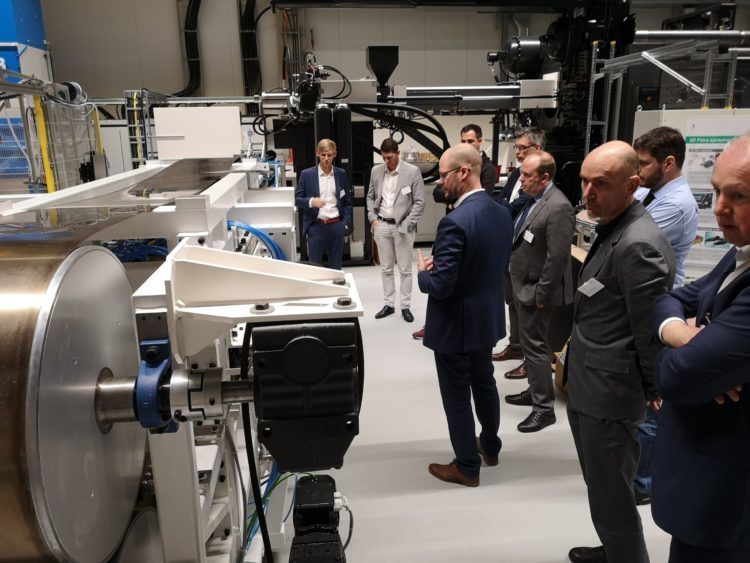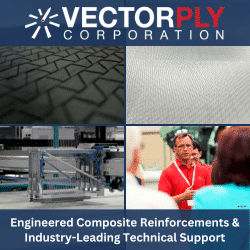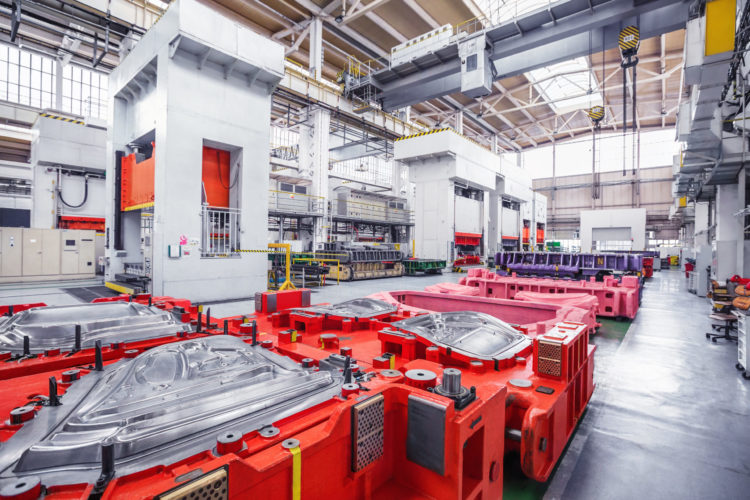

Strength in Numbers
Two years ago, leaders from material supplier Johns Manville and engineering firm Forward Engineering met for the first time at an automotive conference in Michigan. Initial conversations about a shared interest in developing innovative lightweighting solutions quickly led to a formal collaboration between the two companies. In May 2019, the companies participated in a design challenge at ACMA’s Composites Technology Day at Ford Motor Company, presenting a jointly-developed design for a structural thermoplastic battery enclosure.
Collaborations such as this one are key to continued growth of the composites industry. “The industry needs complete solutions,” says Adam Halsband, managing director of Forward Engineering North America LLC. “Bringing together experts at every stage of the product development process and every point along the value chain maximizes the potential to prepare a complete solution that will resonate with the industry.”
While all industries talk about the importance of breaking down silos and working together, collaboration is imperative in the highly complex world of composites with exacting demands on material performance, processing technologies and end-use requirements.
“A broader view from different perspectives provides a much wider spectrum of information regarding requirements of the market, but also more versatile solutions,” says Martin Grosskreutz, sales director of Roth Composite Machinery. “The composites industry has a bright future if companies, government agencies, universities and other institutions see the benefits and enhance the implementation of composites in our daily life.”
A Network of Companies
In June, Roth Composite Machinery launched a four-year partnership with AZL Aachen GmbH. One of the initial activities will be contributing to a joint study on filament winding technologies for composite pressure tanks as part of AZL’s workgroup on composite pipes and vessels. The working group is one of six spearheaded by AZL, which partners with more than 80 companies to pursue business and technology development.
“We offer our network a systematic approach to jointly identify business opportunities and market potential for lightweight technologies,” says Kai Fischer, managing partner of AZL Aachen GmbH. “We then develop these technologies involving our partners from industry and our high-tech ecosystem at the RWTH Aachen University campus, where several hundred collaborations on composite and lightweight solutions are initiated each year.” AZL partners have completed many projects, including material and processing benchmarks for thermoplastic tapes, ultra-fast manufacturing of tailored composite blanks and development of a low-cost, energy-efficient double belt press.
The new benchmarking study aims to provide economic insights on composite technologies in high pressure vessels, a key enabling technology for sustainable transportation in automotive, trucks and rail. AZL has assembled a team of experts along the value chain to provide realistic production figures and cost, including Roth Composite Machinery.
“We’ve seen enormous cost reduction in carbon fiber pressure vessels in the upper two-digit percentage range within the last decade because of the transformation to high-volume production,” says Michael Emonts, managing partner of AZL Aachen GmbH. “Future cost cuts will require a more efficient use of materials. This can only be achieved by close cooperation of experts along the entire process chain who discuss fields of action, derive roadmaps and implement R&D projects.”
As an equipment supplier that has installed more than 550 machines around the world, Roth offers expertise in filament winding technology processes. “We can contribute a very special and detailed knowledge as to what filament winding processes require, how they work and which productivity advantages they can offer,” says Andreas Reimann, managing director of Roth Composite Machinery.
Complementary Expertise
Just as AZL fosters industry growth through collaboration, so too does ACMA as the industry’s largest trade association. “The Composites Technology Day at Ford that ACMA initiated really created a mechanism for [Forward Engineering and Johns Manville] to highlight the work we are doing together,” says Halsband.

As part of the event, Ford held a design challenge, assembling a list of several complex parts manufactured by the OEM and asking companies to re-imagine the parts as composites-intensive designs. Participating companies had approximately five weeks to complete the project from the time the challenge was issued to their presentation at the Composites Technology Day. “To do a good job really required the support of multiple companies,” says Halsband. “No single company could do it justice.”

Dana Miloagă agrees. “Unless a company happened to have worked on a related concept, it was very difficult for anyone to respond by themselves,” says Miloagă, product leader for composites at Johns Manville. “We reached out to other companies in our network for specific topics, particularly regarding manufacturability because one of Ford’s requirements for the part was that it can be manufactured in large numbers per year. We wanted to show that the concept we proposed, from a material and manufacturing perspective, met that requirement.”
Miloagă’s team presented a structural battery enclosure made from Johns Manville’s new AP Nylon 6 Organosheets, which utilize a proprietary continuous manufacturing process featuring in situ polymerization of caprolactum to form the polyamide 6 thermoplastic. While Johns Manville is the materials expert, Forward Engineering contributed its know-how in simulation-driven design and production-based engineering. In addition, the firm has worked on battery electric vehicles and battery enclosures for several years.
“One of the challenges faced by companies further up the value chain is translating the unique features of your product to attributes that resonate with the end customer,” says Miloagă. “Putting those attributes into the context of a finished part completely changes the conversation and was a key driver for this initiative”
Miloagă adds that as a material supplier, Johns Mansville was excited to have a design engineering firm on its side. “The more aspects of a solution you have in a collaboration – materials, design and manufacturing – the more credibly you are able to present the value proposition and the greater the chances that solution will be considered [by an OEM] and make its way into a commercial application,” she says.
A Good Material Match
Perhaps the most common collaborations within the composites industry are among suppliers who work together to ensure that specific combinations of materials yield the right results. While it may not seem novel for suppliers of resins, reinforcements, additives and fillers, core materials and surface finishes to team up, it’s incredibly important – and might not happen as often as you think or to the degree required.
One example of a true partnership is the collaboration between 3A Composites Core Materials and Vectorply Corporation, both of whom distribute their products through Composites One. The two material suppliers have worked on projects together for more than a dozen years, but began taking their relationship to the next level in 2017.
“Glass and core are natural collaborative ingredients to a laminate,” says Richard Knipe, sales director for 3A Composites. “Over the last three years, we’ve developed proprietary combination products.” Many of the products are designed for infusion processing.
“When customers switch from open mold to infusion, they often experience challenges in achieving the cosmetic surface they were used to with open mold laminates,” says Knipe. “To assist, we collaborate with Vectorply, who stitch their glass fiber to our core. By doing so, we create a far better cosmetic condition and eliminate a step for the customer in laying out the glass and the core separately.”
The companies currently have nearly 100 combinations of glass and core for the marine and industrial markets, and they are moving into aerospace. “Vectorply and 3A are continuously working on closed mold applications where our joint goal is to bring consistent thickness, flow and cosmetics with a single fabric solution while reducing overall cost,” says Tamir Levy, vice president of sales for Vectorply.
Working together helps ensure that suppliers don’t think solely about their product – their narrow piece of the puzzle. “You have to look at the total solution, and a lot of the solution is in the process,” says Jordan Haar, southeast regional sales manager for Vectorply. “It’s about constantly pushing the envelope by taking more feed lines out, more consumables out and reducing the cycle times required by manufacturers.”
Although team members from 3A and Vectorply don’t share office space, they are in constant communication and, before the COVID-19 pandemic, often met in person at customer’s facilities, trade shows, golf outings and other venues. Developing strong professional and personal relationships with fellow suppliers breeds innovation, says Levy.
Tips to Foster Teamwork
Composites industry professionals involved in collaborations echo a statement made by Levy. “The more collaboration we have, the brighter the future will look for our industry,” he says. But believing in the concept of collaboration is quite different from making cross-industry partnerships work in day-to-day operations. Here are eight tips for finding partners and cultivating collaborations:
- Let your customers be your guide. A close examination of your customers’ products may lead you to potential colleagues. “If you go to enough customers and see a trend, such as a particular gel coat they like, you may realize that gel coat will make your product look a lot better,” says Knipe. “It makes sense to call that gel coat supplier and find out how you can collaborate. If I can approach a company and say, ‘I think together we can increase our sales,’ who doesn’t want to do that?”
- Find a partner with shared values. Sharing a vision for a product isn’t enough to sustain a relationship. “We want our partners to share our passion for engineering services, product quality and overall responsiveness to the customer,” says Levy. “If the partners we choose to collaborate with don’t share these values, we can suffer. Our only sustainable competitive advantage is our reputation.”
- Understand your company’s intellectual property and unique strengths. “Once you know that space, you can protect it and that gives you comfort to reach out and speak with potential partners who can help fill gaps and advance solutions,” says Miloagă. “This also gives you strength internally because once you identify potential collaborations, you still have to propose those to your company and get your team’s buy in.”
- Take care of the business nuts and bolts. This may include drafting and signing a non-disclosure agreement (NDA) before beginning work together. You also should agree in advance on project priorities, milestones, responsibilities and timelines.
- Keep the lines of communication open. “Just like in every situation in private life or in business, the three most important factors to keeping a relationship strong are communication, communication, communication!” says Grosskreutz. Be honest and open, even when you disagree or problems arise that could derail a relationship.
- Socialize outside of the business setting. It helps to strengthen relationships over a shared dinner, round of golf or, these days, a happy hour Zoom call. “Rather than just being two companies collaborating because of customers’ needs, we are friends,” says Levy. “That ultimately benefits the customer because there is a lot of team building and support required to provide service to them.”
- Invest in shared tools and processes. To help create a seamless workflow between partner organizations, it helps to use the same tools. These might include design software, cloud sharing platforms, key performance indicators, financial models and more.
- Get down to business. “In the end, strong collaborations are not built on exchanging ideas and drinking coffee, but on implementing joint projects directly from the meeting room into the tech center,” says Fischer. Make sure you have a clear vision of how the work will be carried out and metrics in place to track progress.
In the end, industry collaboration takes time, work and resources. But the effort is worth it not just individually, but collectively.
“The composites industry as a whole is young. We are coming up with innovative products that have well-known benefits over traditional materials,” says Scott Phillips, marketing manager of Vectorply. “As we penetrate new markets, the more collaboration that happens between companies, governmental agencies, educational institutions and others, the better for the entire composites industry.”

SUBSCRIBE TO CM MAGAZINE
Composites Manufacturing Magazine is the official publication of the American Composites Manufacturers Association. Subscribe to get a free annual subscription to Composites Manufacturing Magazine and receive composites industry insights you can’t get anywhere else.





